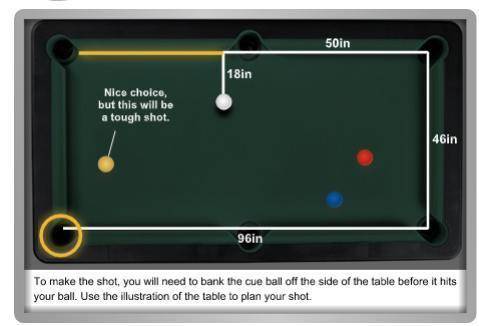WILL GIVE POINTS
Setting Up for the Shot.
You're playing a game of pool and it's your turn,...

Mathematics, 12.12.2021 22:50, stephany6523
WILL GIVE POINTS
Setting Up for the Shot.
You're playing a game of pool and it's your turn, but you have no direct shots. To make any shot, you will need to bank the cue ball (the white ball) off the side of the table before it hits your ball. That means that you hit the cue ball so that it bounces off the side and then hits your colored ball, moving it in the direction of a pocket (hole). The angle that the ball hits the bumper is equal to the angle that it bounces off the bumper.
The cue ball is 18 inches from the top bumper (side of pool table) and 50 inches from the right bumper. The dimensions of the pool table are 96 inches in the horizontal direction by 46 inches in the vertical direction. Use the illustration of the table and what you know about similar triangles to plan your shot.
1. Which ball did you select? Red, yellow, or blue? (1 point: 1 point for selection)
2. Construct a triangle by performing each of these steps. (6 points: 1 point for each step)
a. Label the cue (white) ball A.
b. Identify the pocket (hole) that you want your ball to go in. Label the center of this pocket E.
(Hint: Click on the ball in the image on the Pool Table Problem page to see how to make this shot.)
c. Draw a line segment that starts at E, goes through the colored ball, and ends at the other side of the table. Label the other endpoint of the segment C.
d. Draw a line segment from C to A (the cue ball). This segment will make the same angle with the bumper as CE.
e. Draw a perpendicular line segment from A to the same bumper (side of table) C is on. Label the endpoint B.
f. Complete triangle ABC by drawing the line segment BC.
3. Complete triangle CDE that is similar to ABC. Where does D need to be to create a similar triangle? Label vertex D and mark the angles that have the same measure. (2 points)
4. Assign a variable to name the length of BC and label it on your figure. To identify the lengths of AB, CD, and DE, use the dimensions of the pool table. Some lengths will include a variable. (4 points: 1 point for each label)
5. Use your similar triangles to set up a proportion. Solve this proportion for the unknown variable, the length of BC. (5 points: 2 points for the proportion, 3 points for the work.
6. To make your shot, you need the cue ball to hit point C. Find length CD and use it to identify the location of C in relation to one of the corner pockets. For example, if C is on the upper bumper, your answer might be: 15 inches to the right of the upper left pocket. Round your answer to the nearest inch. (2 points: 1 point for distance, 1 point for location)


Answers: 1
Other questions on the subject: Mathematics

Mathematics, 20.06.2019 18:04, allenlitterell
If the public debt of a country in 2009 was $10432000000000 and the budget for 2010 was in deficit by $201645000000, what was the public debt in 2010? do not include commas in your answer.
Answers: 3

Mathematics, 21.06.2019 17:10, ivilkas23
The frequency table shows a set of data collected by a doctor for adult patients who were diagnosed with a strain of influenza. patients with influenza age range number of sick patients 25 to 29 30 to 34 35 to 39 40 to 45 which dot plot could represent the same data as the frequency table? patients with flu
Answers: 2


Mathematics, 21.06.2019 18:30, Jenniferwolf
Ametal rod needs to be 9 feet and 5.5 inches in length. the sections of the poles being used are each 1 foot and 10.5 inches long. how many 1ft 10.5in sections would be needed to complete the 9ft 5.5in metal rod? and how many inches of material will be left?
Answers: 1
Do you know the correct answer?
Questions in other subjects:








Mathematics, 07.03.2020 03:17








